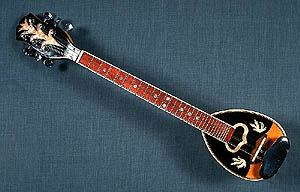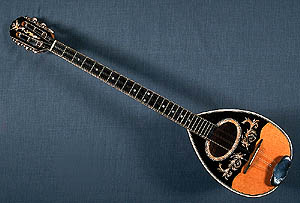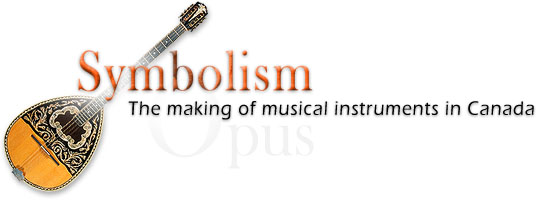|
|
 |
 he
baglama and the tzouras are small, long-necked lutes derived from the
bouzouki. The three instruments make up the typical ensemble associated with
rebetiko music and songs. This music, with its strong Turkish
influence, appeared in Greek port cities late in the last century. It soon
became the music of the streets and cafés, associated with
a tough milieu. In the 1920s, the baglama and the tzouras met with
the same social disfavour as the bouzouki. Today, the popularity of these
instruments has been restored by virtuoso Greek musicians. he
baglama and the tzouras are small, long-necked lutes derived from the
bouzouki. The three instruments make up the typical ensemble associated with
rebetiko music and songs. This music, with its strong Turkish
influence, appeared in Greek port cities late in the last century. It soon
became the music of the streets and cafés, associated with
a tough milieu. In the 1920s, the baglama and the tzouras met with
the same social disfavour as the bouzouki. Today, the popularity of these
instruments has been restored by virtuoso Greek musicians.
| |
 Baglama
Baglama
By
Constantin Tingas
Toronto, Ontario
1991
Maple, ebony, spruce, linden, African padouk
Overall length: 57 cm;
body: 16 x 12 cm;
depth: 6 cm
|
Opus 94 - Tzouras
| |
 Tzouras
Tzouras
By
Constantin Tingas
Toronto, Ontario
1991
Walnut, ash, spruce, linden, ebony, African padouk, plastic
Overall length: 87.5 cm;
body: 27.5 x 20.5 cm;
depth: 15 cm
|
Opus 95 - Lyra
Originating in the Greek Islands, the lyra is used mostly on Crete and in
the Dodecanese. Traditionally, only men played it, to perform dance music.
Until the middle of this century, small bells were attached to the bow to
provide rhythmic accompaniment. Today, when it is not replaced by the violin,
the lyra may be played alone or with instruments such as the laouto, the
daouli drum, and dachares tambourines. It is
also played with Western instruments.
The body of this lyra was carved from a single piece of mahogany.
The soundboard is made of spruce.
| |

Lyra
By
Constantin Tingas
Toronto, Ontario
1991
Honduran mahogany, spruce
Overall length: 55 cm;
body: 28 x 21 cm;
depth: 5 cm
|
|






